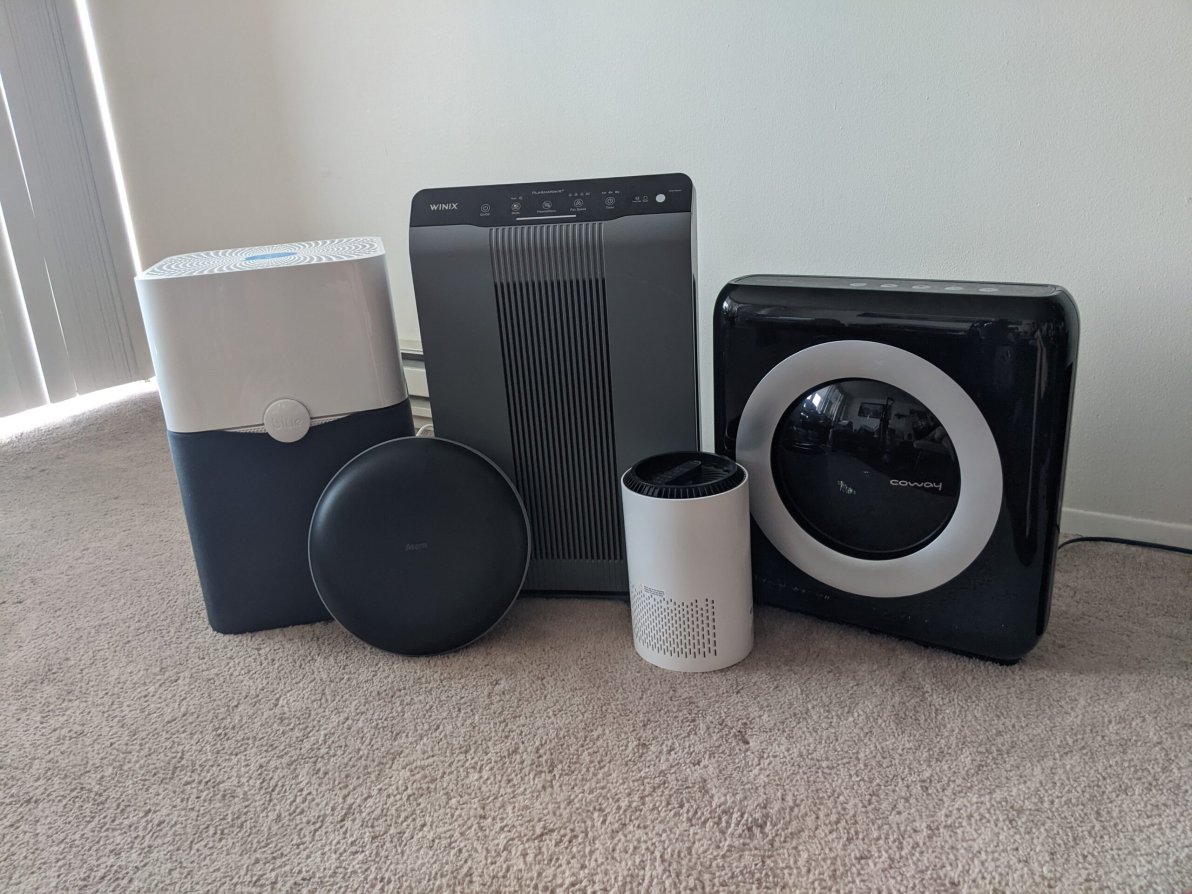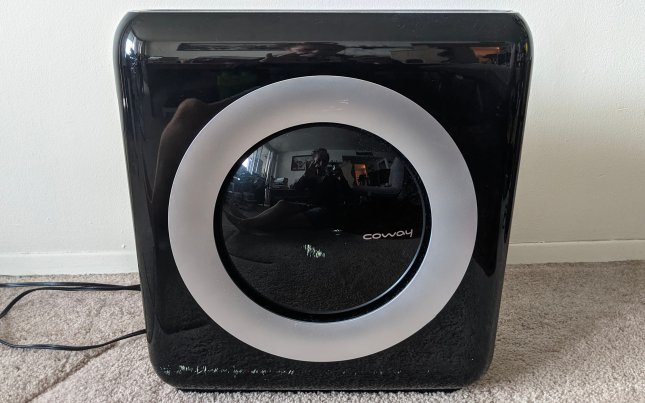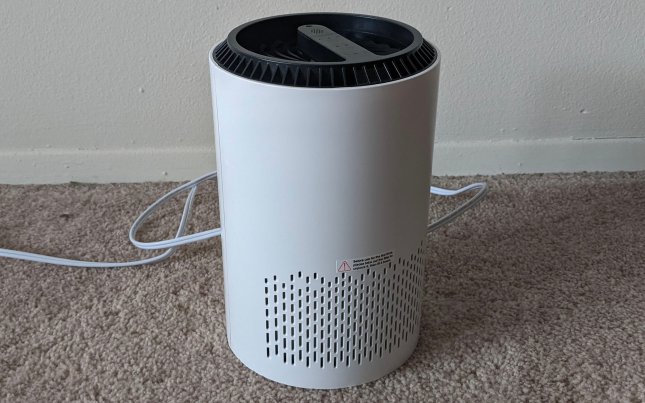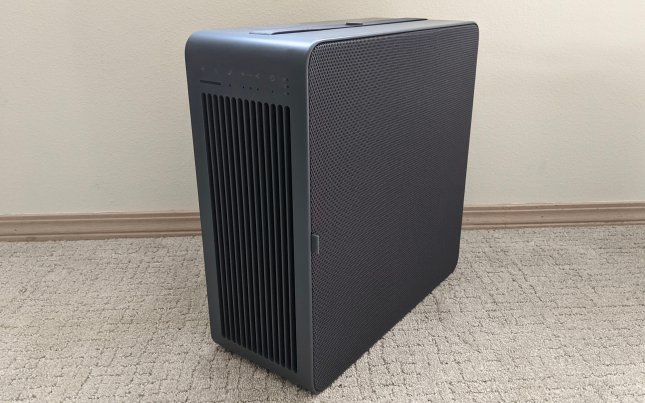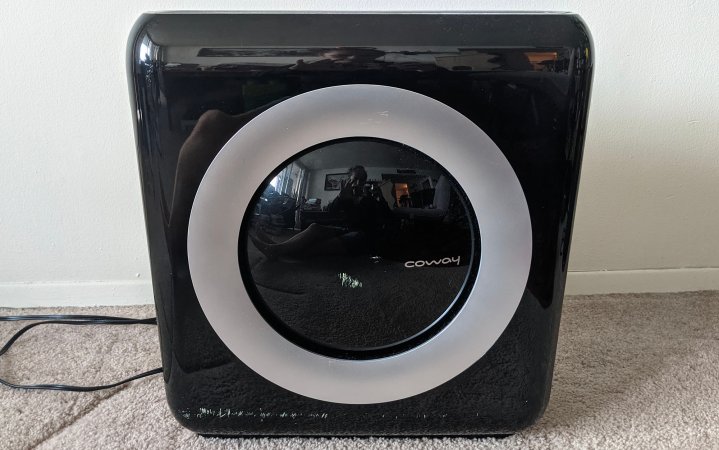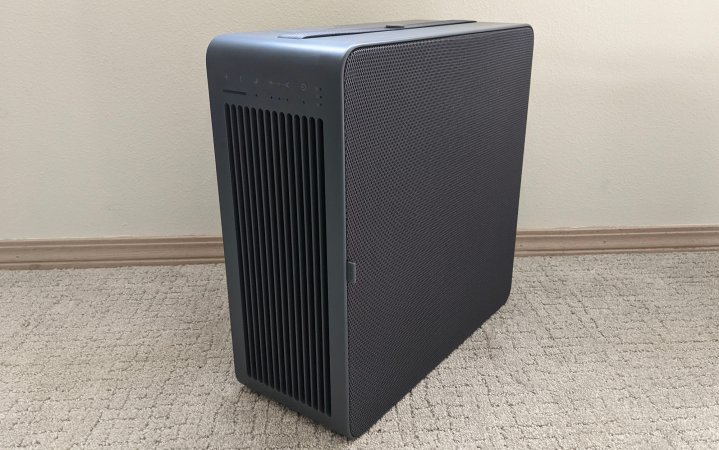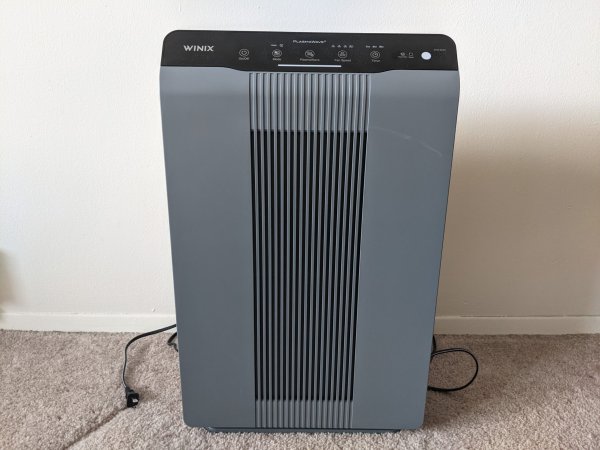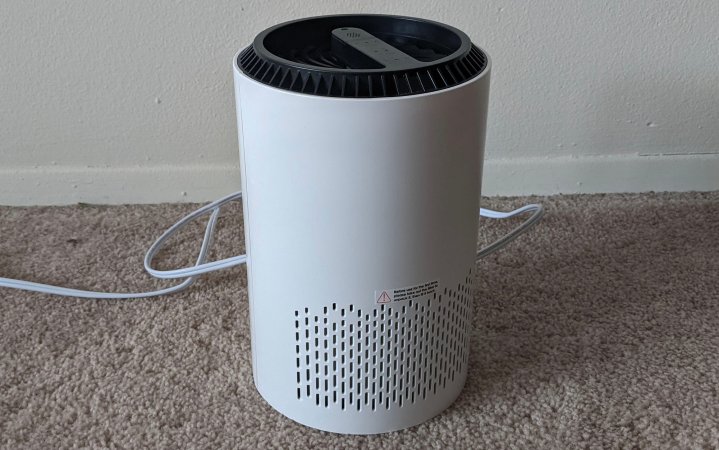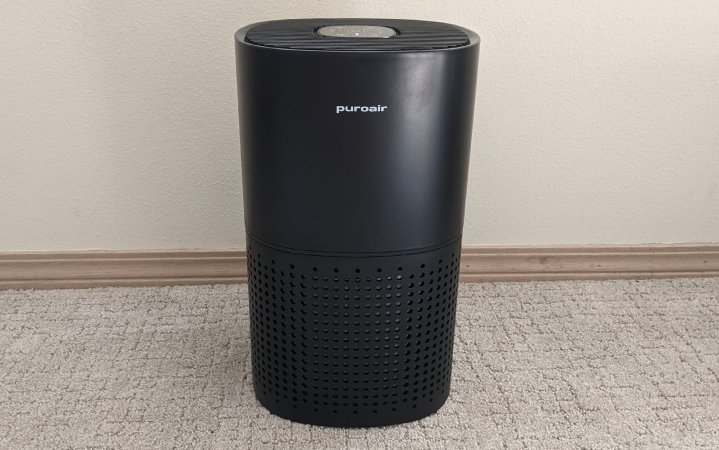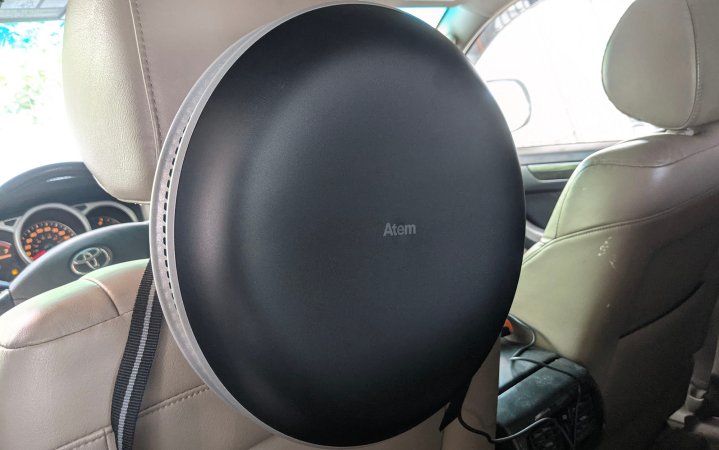We may earn revenue from the products available on this page and participate in affiliate programs. Learn More ›
Every year wildfire smoke creeps farther and farther across the United States, exposing the importance of having a few air purifiers for smoke. While the casual smoke exposure of a campfire or outdoor barbecue typically won’t negatively affect your health, prolonged exposure to AQIs in the 100 range or higher can leave you coughing and wheezing, struggling to breathe with eyes stinging. Wildfire smoke can majorly impact human health for just about anyone, but children and senior citizens are particularly at risk. If you haven’t already purchased one of the best air purifiers for smoke, here’s a close look at some of the top options in this category.
- Best Overall: Coway Airmega AP-1512HH
- Best Upgrade: Airthings Renew
- Best for a Kid’s Bedroom: Winix 5500-2
- Best for Large Rooms: Blueair Purifier Large Room
- Best Budget: AROEVE Air Purifier
- DIY: Box Fan Air Purifier
- Iris Woozoo
- PuroAir
- IQAir Atem
How I Tested the Best Air Purifiers for Smoke
For this test, I focused on PM 2.5, knowing that increased PM 10 levels are strongly correlated with PM 2.5. To artificially create an environment with increased levels of 2.5, I went into an enclosed space (my bathroom) and burned a small amount of carbon material (a napkin). I used a Temtop Air Quality monitor to check how high PM 2.5 levels in the bathroom went, turning on the air purifiers for smoke once they were more than 250. I also tested for the IQ Air Atem in my car (a Toyota 4runner).

I recorded the time for the air purifiers for smoke to drop to below 50 PM 2.5, 10 PM 2.5, and then below 1 PM 2.5. For comparison, governmental guidelines suggest keeping 24-hour exposure levels below 35 PM 2.5, with a long-term (annual) target of 15 PM 2.5.
Read Next: Best Air Quality Monitors
Watts used were measured using a Kill-a-Watt when the air purifier was set to its highest setting. Price, aesthetics, and ease of use were also taken into consideration when making my recommendations.
| Air Purifier | Unit Price | Replacement Filter Price | Weight | Time to Reduce PM 2.5 from 50 to 10 | Max Power Usage |
|---|---|---|---|---|---|
| Airthings Renew | $400 | $70 | 11.9 pounds | 1 minute, 45 seconds | 30 watts |
| AROEVE | $50 | $23 for 2 | 3 pounds | 8 minutes | 24 watts |
| Blueair Purifier Large Room | $340 | $90 | 13 pounds | 1 minute | 73 watts |
| Coway Airmega AP-1512HH | $230 | $40 | 12.5 pounds | 2 minutes | 64 watts |
| IQAir Atem | $400 | $90 | 6.3 pounds | N/A | 1 watt |
| Iris Woozoo H13 | $300 | Unavailable | 14.8 pounds | 1 minute, 45 seconds | 31 watts |
| PuroAir | $200 | $48 | 8 pounds | 4 minutes, 15 seconds | 45 watts |
| Winix 5500-2 | $250 | $40 | 15.4 pounds | 2 minutes | 69 watts |
The Best Air Purifiers for Smoke: Reviews & Recommendations
Best Overall: Coway Airmega AP-1512HH
Pros
- Works well for bedrooms, but can pull double duty in living rooms if needed
- Handle on the top and lightweight enough to move around easily
- Indicator light turns red when particulate matter levels are too high
Cons
- Includes an air ionizer that can be detrimental to health if used
- Melodic tones whenever you press a button can be an issue with small children
Key Features
- Weight: 12.5 pounds
- Time to filter PM 2.5 from 50 to 10: 2 minutes
- Max Energy Usage: 64 watts
The Coway Airmega is the first air purifier for smoke I purchased, and it’s still what I would recommend to most people. It’s aesthetically pleasing, quiet on all but its highest settings, and it was a top performer in filtering out PM 2.5 levels. It only took three minutes for it to cut PM 2.5 levels down from 570 to less than 50 in my test, and two more minutes to cut it down below 10. PM 2.5 levels were below 1 in only eight minutes total.
While this unit isn’t for large spaces, I’ve had it pull double-duty more than once, purifying the air of my entire 880-square-foot home. It usually needs to be cranked up to the highest setting to do this, but it gets the job done, and it’s not often that you’d need to purify the air throughout your home anyway.
I do have a few quibbles with the Coway Airmega. The first is that its indicator light is quite bright, causing a noticeable blue (when the air quality is good) glow in the room when the lights are off. It also includes an air ionizer, which is used to catch larger particles in the air. The only trouble is that this uses ozone, which is detrimental to human health in its own right. Finally, the melodic tones it sings whenever you change a setting or turn on the unit are extremely attractive to children—mine would run over to start mashing the buttons whenever I changed a setting.
Best Upgrade: Airthings Renew
Pros
- Air quality monitor and air purifier in one
- Aesthetically pleasing
- Fairly energy effecient
Cons
- Expensive
Key Features
- Weight: 12 pounds
- Time to filter PM 2.5 from 50 to 10: 1 minute, 45 seconds
- Maximum Energy Usage: 30 watts
I was impressed during testing with how quickly the AirThings Renew cleared out the PM 2.5 from the air, especially given its smaller size and lower wattage use. It can clean out the air just as fast as the Iris Woozoo while being a lot more aesthetically pleasing for your home. And it’s faster than the comparatively sized Coway model. Of course, the downside here is that it’s significantly more expensive.
But the true value of the AirThings Renew is that it is also an air quality monitor that is tracking not only PM 2.5 levels but also radon, CO2, and VOCs. (Note that the air purifier can’t do much about the radon or CO2, you’ll need to crack open a window for that). While my testing has found that there are some limitations to integrated air purifier-air quality monitors (the air right next to the purifier will of course be much cleaner than in the rest of your room), I appreciate that this model is tracking this data over time, which can help provide big-picture information as to whether or not you need to make improvements to the ventilation in your home.
Best for a Kid’s Bedroom: Winix 5500-2
Pros
- Performed as well as the Coway during testing
- Handle on the top and lightweight enough to move around easily
Cons
- Less aesthetically pleasing and slightly more obtrusive than the Coway
- Has cute melodic tones and a bright blue light (but less abrasive than the Coway)
Key Features
- Weight: 15.4 pounds
- Time to Filter PM 2.5 from 50 to 10: 2 minutes
- Max Energy Usage: 69 watts
For me, the Coway Airmega’s ionizer—coupled with my child’s love of pressing buttons—makes this one a no-go for her bedroom. Fortunately, during testing, a unit performed at the same level as the Coway and was a lot harder for her to mess with: the Winix. At the same time, it suffers from the same problems as the Coway (melodic tones that chime whenever you press a button, a bright light that gets covered with a cloth at nighttime, an ionizer that produces a small amount of ozone (although not so much as to be a health risk). The buttons were less distinct than the Coway’s, and the height and angle of the display didn’t as closely mimic the display of a typical child’s toy. It’s not perfect—a high-performing air purifier without the chirping and the ionizer would be ideal—but it ultimately caused fewer issues than the Coway.
The only thing I didn’t like about the Winix is that it’s just big—taller and less attractive than the other best air purifiers for smoke I looked at. Keep this one tucked away in the corner of your child’s bedroom, set to the lowest setting, and only look at it when you need to change the filter.
Best for Large Rooms: Blueair Purifier Large Room
Pros
- High performing during my test
- Aesthetically pleasing
- No music when you press a button
Cons
- Comparatively difficult to move
- Sensitive controls are easy to brush against
Key Features
- Weight: 13 pounds
- Time to Filter PM 2.5 from 50 to 10: 1 minute
- Max Energy Use: 73 watts
While the other top air purifiers in my test pulled in air from only one direction, the Blueair Purifier pulled it from every direction. That didn’t make a big difference in my test (in an enclosed space), but that would help in a larger room by increasing the volume of air it’s taking in. And the Blueair is actually nice enough looking, and quiet enough to do just that.
I also appreciated that its controls were comparatively simple, with just one button that didn’t try to sing me a lullaby whenever I touched it. Unfortunately, the button is also surprisingly sensitive. Time and again, I would find that the unit was either off or on high because my leg had brushed against it without my noticing.
The other downside to the Blueair is that it could be easier to move. Picking it up from the sides causes the top to come off; it must be picked up from the bottom.
Best Budget: AROEVE Air Purifier
Pros
- Affordable
- Low electricity usage
- Very small size
Cons
- Not as effective as larger, more expensive units
Key Features
- Weight: 3 pounds
- Time to Filter PM 2.5 from 50 to 10: 8 minutes
- Max Energy Use: 24 watts
It can be hard to justify the price of air purifiers for smoke if you’re preparing for a possible smoke event rather than living through one currently. So I tried out the AROEVE, a budget brand that’s often available when more high-end units are out of stock, to see how it worked.
During my test of the AROEVE, the PM 2.5 level ended up shooting up to 820, the highest level during my main test. I took the air purifier about 8 minutes to get PM 2.5 levels below 250, and another nine minutes to get them below 50 again. Twenty-five minutes from the start of the test, PM 2.5 levels were below 10.
While not as impressive a performance as the Coway Airmega, Winix, or Blueair, this is a great unit to have on hand in the event an unexpected smoke event wafts in through the windows this summer.
DIY: Box Fan Air Purifier
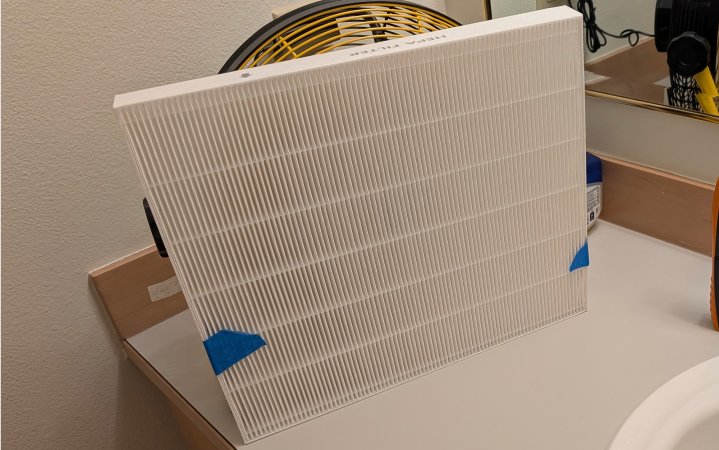
Photo by Laura Lancaster
If you’ve ever been caught unprepared during wildfire season, you know just how difficult it can be to get an air purifier when a major smoke event is underway. Fortunately, you don’t need a full air purifier for smoke setup; all you really need is a HEPA filter. The HEPA filter is what is actually taking the PM 2.5 smoke particulates out of the air, the rest of the filter is just designed to efficiently push air through it.
You can make your own “air purifier” by just grabbing a HEPA filter from your local hardware store — these are usually in stock long after the complete air purifier systems have flown off the shelves — and strapping it to the front of a fan. And attaching it doesn’t need to be a major operation. In my test, all I used were two pieces of masking tape.
I decided to try this for myself, by strapping a spare HEPA filter to the front of one of the best camping fans. The results were more than impressive. On high, the fan cleared the air from 50 PM 2.5 to 10 PM 2.5 in 2 minutes, 20 seconds. This one isn’t going to win any energy efficiency awards, but if you are in a pinch, it’s a great backup to have in your toolkit.
Iris Woozoo
Pros
- Cleans the air quickly
- Small footprint
- Childlock
- Energy effecient
Cons
- Built-in air quality monitor doesn’t work as well as I had hoped
Key Features
- Weight: 14.8 pounds
- Time to Filter PM 2.5 from 50 to 10: 1 minute, 45 seconds
- Max Energy Use: 31 watts
2025 Update: While I had recommended this as one of the most efficient units previously, in my most recent update I was unable to find a replacement filter for this unit. Look to make sure you can purchase a replacement filter — which should be changed out a minimum of once a year — before making a final purchase.
Most air purifiers can be energy hogs if you leave them on their highest settings for too long. So I was glad to see that during testing, the Iris Woozoo proved to be unusually efficient. It brought the PM 2.5 levels in my testing room down from 50 to 10 in less time than either the Coway Airmega or the Winix, and did it using less power than either of those to boot. In fact, on its lowest settings, I couldn’t even get a reading on how much power it was using. Despite its large size, however, the Woozoo turned out to be noticeably less powerful than the more expensive Blueair Purifier.
While the Woozoo is easier to move around than the Blueair, it was noticeably less portable than my top pick, due to its overall size and lack of a handle. It also included a surprisingly array of options to cycle through, some of which were useful, and others of which were simply distracting. This was the only air purifier I’ve looked at that featured a child lock, which would help to keep little hands from incessantly pushing buttons to see the lights and hear the melodic ding of a cycle change. It also featured five different air volume speeds in addition to a turbo mode and a sleep mode. In my experience, this is about four options too many, and it’s unclear why they aren’t simply set up as seven different speeds for user convenience.

While I was initially excited that this air purifier had a built in air quality monitor, I was ultimately disappointed with how well it functioned in practice. During testing it consistently showed a much lower volume of PM 2.5 than the air quality monitor I used for testing (the Temtop PM 2.5 monitor), which was only situated a foot or so away. My sense is that having an air quality monitor attached to your air purifier is not going to give you a great reading of the overall indoor air quality conditions. A better practice would be to place a separate air quality monitor on the opposite side of the room from your air purifier to ensure accurate readings.
PuroAir
Pros
- Lightweight
- Reasonably priced
Cons
- Slower to clean the air than other models I tested
Key Features
- Weight: 8 pounds
- Time to Filter PM 2.5 from 50 to 10: 4 minutes. 15 seconds
- Max Energy Use 45 watts
Like the Aroeve, the PuroAir is a smaller sized air purifier that will eventually clean the air in your room, but won’t get it done all that quickly. In testing it took about twice as long as the average to clean the PM 2.5 particles out of my bathroom without being especially energy efficient. And while the upfront cost is lower than my best overall, the cost of the replacement filter will negate that in a few years.
IQAir Atem
Pros
- Easy to install
- Extremely quiet
Cons
- Did not purify air very well
- Difficult to adjust while driving
- Expensive
Key Features
- Weight: 6.3 pounds
- Time to Filter PM 2.5 from 50 to 10: N/A
- Max Energy Use: 1 watt
One of the biggest challenges with a smoke event is cabin fever — getting stuck inside your house while you wait for some wind or rain to clean the outdoor air can be taxing. So I was excited to try out the IQAir Atem, which is an air purifier for smoke specifically designed for your car. It attaches to the back of the driver or passenger seat headrest inside your vehicle and plugs into the car cigarette lighter. It’s also quiet—easily the quietest unit I tested of the lot.
Unfortunately, it just didn’t work very well. Of course, the testing here looked a little different: burning a napkin had a more deleterious effect on air quality inside my car than in my bathroom. The PM 2.5 levels shot above 999, at which point I turned on my car’s fan to get the air moving and then turned it back down again a few minutes later when it started to drop below 900. Twenty minutes into testing, PM 2.5 levels were still at 140. It wasn’t doing nothing, but it was working so slowly that I would likely arrive at my destination before the air quality in my car improved. If you can purchase a HEPA filter for your existing cabin filter, that is almost certainly a better investment than this product.
Things to Consider Before Buying Air Purifiers for Smoke
Wildfire Smoke

I’ve been using air purifiers for smoke since September 2020, when outdoor quality levels in Seattle, where I live, oscillated between “very unhealthy” and “hazardous” for five days. My daughter was one year old at the time, and knowing the correlation between smoke inhalation and health outcomes (particularly asthma), I wasn’t taking any chances. Since then, we typically turn the air purifier on at night or when something burns on the stove, keeping a spare HEPA filter in the closet in case of another smoke event.
Two types of particulates typically get measured during smoke events: PM 2.5 and PM 10 (PM here stands for “particulate matter”). The numbers refer to the size of the smoke particles in micrometers, with PM 10 being 10 micrometers or shorter and PM 2.5s being 2.5 micrometers or shorter. According to the CDC, PM 10 are irritants for the eyes, nose, and throat (dust from the road and pet dander would fall into this category), white PM 2.5 is small enough to enter your bloodstream. According to the EPA, this can affect both your heart and lungs, increasing your risk of cardiac arrhythmias and heart attacks, asthma attacks, and bronchitis. Young children and the elderly tend to be the most at risk.
HEPA Filter
If an air purifier for smoke doesn’t have a HEPA filter, don’t even bother purchasing it. These are the only filters capable of filtering out the particle size that can cause the most damage to our cardiovascular and respiratory systems. In fact, if you can find a HEPA filter, but not an air purifier during a smoke event, many people have successfully lowered their PM 2.5 levels by simply taping the filter to a box fan and letting it run.
HEPA filters need to be changed on a periodic basis, so check the manufacturer instructions to determine when the best time to do this is. If a substantial smoke event hits, it’s a great idea to change your HEPA filter after that as well.
Square Footage
Typically people purchase an air purifier for smoke for their bedroom (and children’s bedrooms), and then a second one for their main living area. The ones in your bedroom can typically be smaller and less powerful than the ones in your main living area, as they circulate less air.
Energy Consumption of the Best Air Purifiers for Smoke
Air purifiers for smoke use a fairly substantial amount of energy, as much as 70 watts, during our testing. Keep an eye on the setting of your air purifier—the lower the setting you can get away with to achieve optimal air quality in your home, the lower your electricity bill will be.
FAQs
Air purifiers for smoke work by pushing the air in your room through a HEPA filter to clean out PM 2.5 and PM 10 particles.
If you live in an area that is at risk of being impacted by wildfire smoke, then you should have an air purifier for smoke.
Air purifiers are important to have on hand in case of poor air quality due to wildfire smoke, a problem that is becoming increasingly common across the United States.
Final Thoughts on the Best Air Purifiers for Smoke
Purchasing an air purifier for smoke provided my family with an important piece of mind during a stressful smoke event. Since then, we’ve had several other smoke events (although none as dramatic as the original) that have reinforced the importance of that decision and watched as friends and family members across the United States have experienced similar events. If you’ve been putting off purchasing a few air purifiers for smoke, now is a great time to do so, to protect your and your family’s health.
- Best Overall: Coway Airmega AP-1512HH
- Best Upgrade: Airthings Renew
- Best for a Kid’s Bedroom: Winix 5500-2
- Best for Large Rooms: Blueair Purifier Large Room
- Best Budget: AROEVE Air Purifier
- DIY: Box Fan Air Purifier
- Iris Woozoo
- PuroAir
- IQAir Atem
